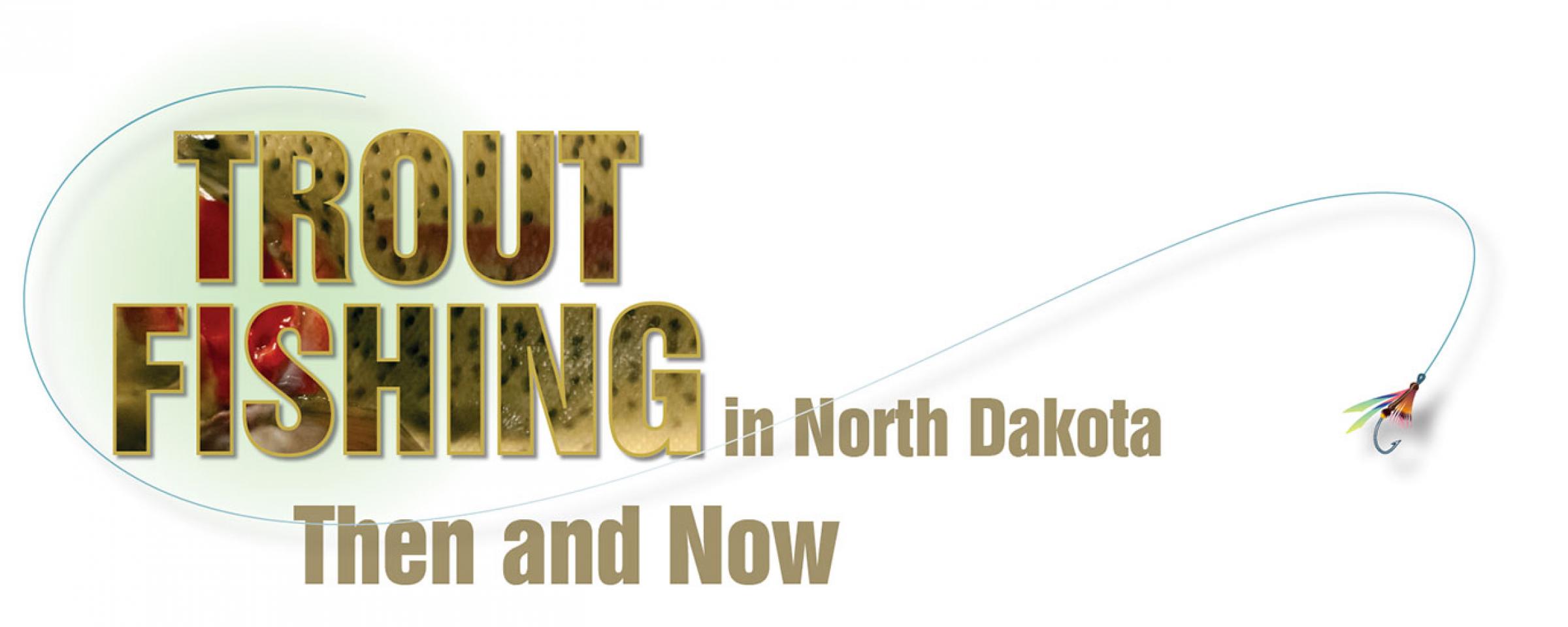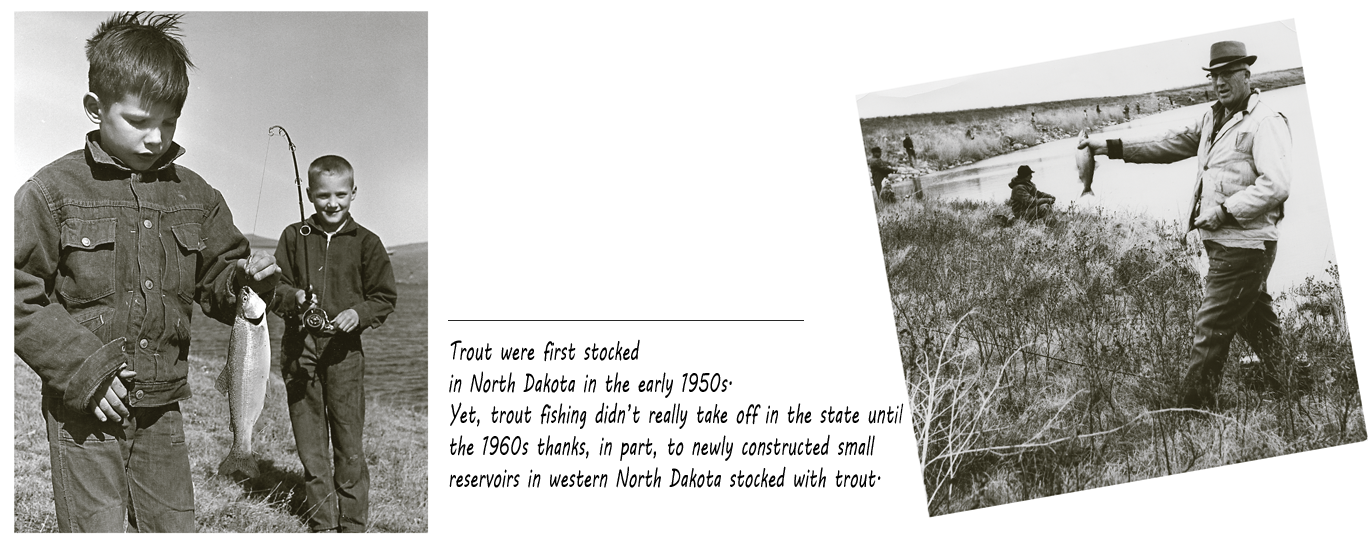
Trout Fishing Then and Now
The reflexive mental image for some people when they hear the words “trout fishing” is of an angler in chest-waders casting a fly-rod in the shadow of some rugged mountains.
In reality, trout fishing in North Dakota doesn’t always include a fly-rod, waders and certainly not mountains. Yet, for years trout have had a place at the table in terms of fishing opportunities for North Dakota anglers.
Understanding both the history of trout fishing in North Dakota, as well as its current status and future prospects, hopefully provides some additional perspective for those in search of this cold water resource.
Trout Then
Trout are represented by a number of species native to North America. As a group, they are highly sought, particularly in the western portion of our continent. Rainbow trout are by far the most popular and widespread trout species, and include many strains that have evolved over time. Brown, cutthroat, lake and brook trout are other species commonly noted in United States waters.
When the Lewis and Clark expedition paddled through what became North Dakota in the early 1800s, careful attention was given to documenting the Missouri River flora and fauna. Although numerous fish species were collected, trout were not one of them. And for good reason, as they are not native to our state.
Consequently, providing trout fishing opportunities in North Dakota requires ongoing stocking to maintain populations. The first recorded trout stocking in the state was 1954 (Gordon Lake). However, in all likelihood some residents stocked trout throughout the state for years prior, as this was an encouraged practice in the early 1900s.
Although trout were likely not present, the first regulation in North Dakota’s books for trout, which were grouped with a number of other species, was 1911. In 1955, the first daily limit of five fish was set for trout.
Trout fishing in North Dakota really took off in the 1960s due to two factors:
- The establishment of new trout lakes, primarily newly created small reservoirs in western North Dakota.
- A new stocking program.
By 1964, there was enough interest and harvest of trout that lakes were delineated into Class I and Class II trout lakes, the differences dealing with limits and season length.
Interest continued to grow and by 1970, 12 percent of all resident North Dakota anglers listed trout as their preferred species. By 1976, we had 48 trout lakes listed with specific restrictions. It was during this time period – late 1960s through the late 1970s – that interest in trout fishing peaked.
Because trout are relatively expensive to raise and stock, coupled with a fledgling salmon fishery in Lake Sakakawea, a trout and salmon stamp was established in 1984. Anglers fishing for trout or salmon had to purchase and possess this stamp.
The intent was for revenue generated from the stamp to pay for stocking and managing of the state’s trout and salmon populations. Annual sales peaked around 27,000 in 1987, but rapidly decreased to barely 12,000 in 1992-93. In 1995, the trout and salmon stamp was eliminated.
While the stamp generated roughly $50,000 to $100,000 annually, it was not supporting the cold water fishing program. In addition, interest in trout (and salmon) fishing decreased considerably during the late 1980s, due to severe drought and rapidly growing walleye and yellow perch fisheries in the state.
By 1990, only 1 percent of the anglers responded that trout was their fish species of choice. In 1993, the special Class I and II designations for trout lakes was eliminated, as those regulations were no longer relevant to trout management in North Dakota.

Trout Now
Due to a slow but progressive decline in water quality, trout can no longer survive winter, or summer in some cases, in some of the lakes that historically supported them. However, even though the glory days (1960s and 1970s) of trout fishing in North Dakota are past, the Game and Fish Department stills stocks quality sized trout into 45-55 lakes annually.
Based on different criteria, there are generally two types of water bodies that are stocked with trout. First, in the past 10-15 years, Game and Fish has aggressively developed small, local community fisheries, often using the Department’s Save Our Lakes program in creating opportunities. These water bodies are also generally shallow and susceptible to winter/summer kills.
The Department stocks catchable-sized trout in spring (usually May), with the hopes that local anglers, especially youth and elderly, target these fish before the water warms. Local support has always been strong in assisting the efforts to develop these fisheries.
Second, the Department stocks some of the state’s traditional reservoirs, especially in western North Dakota. Due to preferred temperatures and adequate oxygen levels, the risk of summer or winter kill remains generally low in these reservoirs, so they can support trout year-round. These waters have the ability to grow larger trout, perhaps up to 5 pounds, which attract the more purist trout anglers.
North Dakota has experimented with various strains of rainbow trout over the years, including Eagle Lake, Shasta, Kamloops, Hot Creek and Firehole. Each strain has some unique characteristics that may increase growth, survival and/or catchability for anglers.
The bread and butter strain used in most North Dakota waters is Shasta. This strain, along with brown trout, account for the vast majority of North Dakota’s stocking effort.
Although most North Dakota anglers seek walleye, yellow perch and/or northern pike, the state does continue to offer some unique opportunities for those seeking quality trout fishing. Since 1994, for example, Turtle River State Park near Grand Forks is stocked a few times a year with thousands of catchable trout. The Turtle River is used by many, including fly-fishers, seeking a nice stream environment to fish.
Another example of a unique fishery is Garrison Dam Tailrace. This water annually receives 40,000 trout (a combination of rainbow and brown trout) and is home to trophy trout. Because Tailrace trout can live for years, and feed on a strong forage base of rainbow smelt coming through the dam, four different trout species state records originate from here, including a 21-plus-pound rainbow and a 31-plus-pound brown trout. Some anglers target these Tailrace trout, resulting in the catch of many rainbows between 5 and 10 pounds.
As in recent years, Garrison Dam National Fish Hatchery, with some assistance from the state of Wyoming, will continue to produce the fish, and the Department will continue to stock around 125,000 catchable-sized trout into approximately 50-plus lakes scattered across the state.
These stockings will provide diverse fishing opportunities in varied fishing environments, always with the goal of providing anglers a good tussle on the other end of their fishing rods. Trout will always have a place in North Dakota’s fishing heritage.
